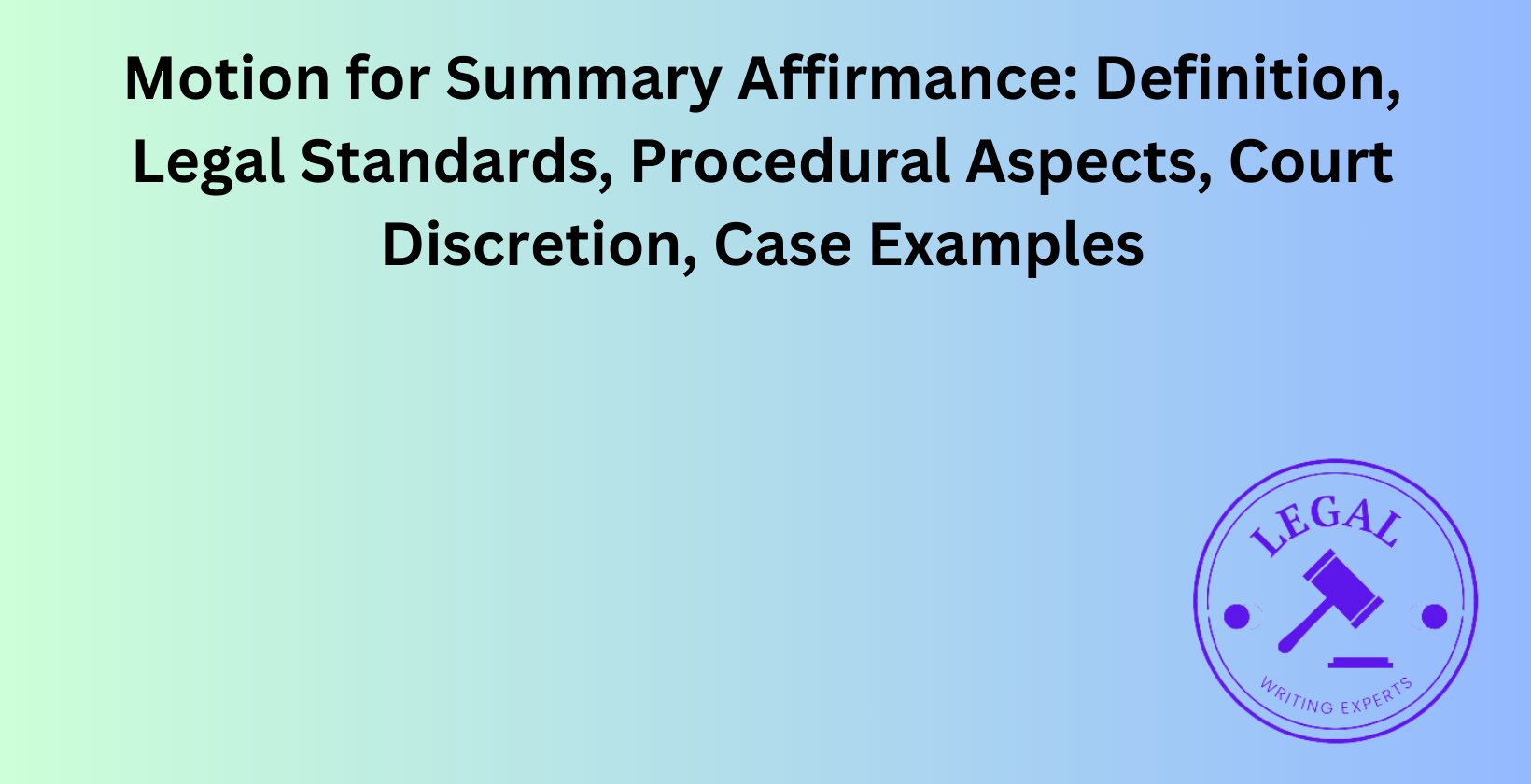Motion for Summary Affirmance
Written by
Jessica E
October 1, 2024 · 8 min read

A motion for summary affirmance is a legal procedure used in appellate courts to expedite the resolution of cases where the outcome is clear based on existing precedent or the lack of substantial issues. This article explores the definition, legal standards, procedural aspects, court discretion, and case examples related to motions for summary affirmance. Understanding these elements is crucial for attorneys and litigants navigating the appellate process, as it can significantly impact the efficiency and outcome of appeals.
What Is a Motion for Summary Affirmance?
A motion for summary affirmance is a request made to an appellate court to uphold a lower court’s decision without full briefing or oral arguments. This procedural tool is used when the issues presented in the appeal are straightforward and can be resolved based on well-established legal principles or precedents. The purpose of such motions is to streamline the appellate process and conserve judicial resources for more complex cases.
How to Write a Motion for Summary Affirmance?
To write a motion for summary affirmance, begin by clearly stating the grounds for the motion. Include a concise statement of the case, highlighting the key facts and procedural history. Present a compelling argument demonstrating why the lower court’s decision should be affirmed without further proceedings. Cite relevant legal authorities and precedents that support your position. Conclude with a specific request for the court to grant summary affirmance. Ensure the motion is well-organized, concise, and adheres to the court’s formatting requirements.
Where Can I Hire a Legal Writer to Draft a Motion for Summary Affirmance?
Legal writers capable of drafting motions for summary affirmance can be found through Legal Writing Experts channel. Legal Writing Experts often have in-house legal writers or contract with freelance legal writers. Legal Writing Experts is an online platform specialized in legal writing services that provide access to experienced legal writers. When hiring, verify the writer’s credentials, experience with appellate motions, and familiarity with the relevant area of law to ensure a high-quality, effective motion.
How to File a Motion for Summary Affirmance?
To file a motion for summary affirmance, first review the specific rules of the appellate court where the case is pending. Prepare the motion document according to the court’s formatting guidelines. Include any required supporting documents or exhibits. File the motion with the clerk of the appellate court, either electronically or in paper form, depending on the court’s requirements. Serve copies of the motion on all parties involved in the appeal. Pay any required filing fees. Ensure compliance with all deadlines specified in the court’s rules for filing such motions.
What Are the Legal Standards for a Motion for Summary Affirmance?
The legal standards for a motion for summary affirmance vary by jurisdiction, but generally include several key elements. The moving party must demonstrate that the appeal presents no substantial question or that the lower court’s decision is clearly correct as a matter of law. There should be no novel legal issues or complex factual disputes requiring extensive review. The motion should show that the outcome is controlled by well-established precedent. Courts typically require clear and convincing evidence that affirmance is appropriate without full briefing or oral arguments.
When Is Summary Affirmance Appropriate in Appellate Cases?
Summary affirmance is appropriate in appellate cases when specific conditions are met. The appeal must present issues that are squarely controlled by existing precedent. No novel legal questions or unique factual situations requiring in-depth analysis should be present. The lower court’s decision must be clearly correct, with any errors being harmless or immaterial to the outcome. Summary affirmance is often used in cases where the appellant’s arguments are frivolous or have been repeatedly rejected in similar cases. It is particularly suitable for appeals that do not warrant the time and resources of full appellate review.
What Are the Procedural Aspects of a Motion for Summary Affirmance?
The procedural aspects of a motion for summary affirmance involve several steps. The motion is typically filed early in the appellate process, often before full briefing begins. The moving party must serve the motion on all other parties involved in the appeal. Opposing parties are usually given an opportunity to respond to the motion within a specified timeframe. The court may decide the motion based solely on the written submissions or may schedule a hearing for oral arguments. If granted, the court issues an order affirming the lower court’s decision without a full opinion. If denied, the appeal proceeds through the normal briefing and argument process.
How Does Court Discretion Affect the Outcome of a Motion for Summary Affirmance?
Court discretion significantly affects the outcome of a motion for summary affirmance. Appellate courts have broad discretion in deciding whether to grant or deny such motions. Judges consider factors such as the clarity of controlling precedent, the complexity of the issues presented, and the overall merits of the appeal. The court’s assessment of judicial economy and the potential impact of a full review on the parties and legal system influences its decision. This discretionary power allows courts to efficiently manage their dockets while ensuring that cases requiring thorough review receive appropriate attention.
What Are Common Case Examples Where Summary Affirmance Was Granted?
Common case examples where summary affirmance was granted include appeals involving well-settled legal principles. Cases with frivolous arguments or those clearly contradicting established precedent are often summarily affirmed. For instance, in criminal appeals where the defendant’s guilt was overwhelmingly established at trial and no significant legal errors occurred, courts may grant summary affirmance. Civil cases involving straightforward contract interpretations or clear statutory violations have been summarily affirmed. Appeals challenging discretionary decisions of lower courts, such as evidentiary rulings or sentencing determinations, frequently result in summary affirmance when no abuse of discretion is apparent.
What Are the Key Differences Between Summary Affirmance and Reversal?
The key differences between summary affirmance and reversal lie in their procedural nature and outcomes. Summary affirmance upholds the lower court’s decision without full appellate review, typically based on clear precedent or lack of substantial issues. It results in a quick resolution affirming the original judgment. Reversal, conversely, overturns the lower court’s decision after a full appellate review process. Reversal requires a finding of significant legal error or misapplication of law by the lower court. While summary affirmance expedites the appellate process, reversal often involves detailed written opinions explaining the court’s reasoning and may result in remand for further proceedings.
Can Summary Affirmance Be Challenged on Appeal?
Yes, summary affirmance can be challenged on appeal, but the options are limited. The primary avenue for challenging a summary affirmance is through a motion for reconsideration or rehearing filed with the same appellate court. This motion must typically demonstrate a clear error of law or fact in the court’s decision to summarily affirm. In rare cases, a petition for review to a higher court (e.g., a state supreme court or the U.S. Supreme Court) may be possible. However, the chances of success in challenging a summary affirmance are generally low, as courts have broad discretion in granting these motions.
What Are the Implications of a Summary Affirmance Without Opinion?
A summary affirmance without opinion has several implications. It upholds the lower court’s decision without providing detailed reasoning, which can limit its precedential value. Parties may find it challenging to understand the specific grounds for affirmance, potentially affecting future litigation strategies. For the prevailing party, it provides a quick resolution and finality to the case. For the losing party, it may limit options for further appeal due to the lack of a written opinion to challenge. In the broader legal context, summary affirmances without opinion can help manage appellate court dockets but may contribute less to the development of case law.
How Does a Motion for Summary Affirmance Interact with Other Appellate Motions?
A motion for summary affirmance interacts with other appellate motions in various ways. It often takes precedence over standard briefing schedules, potentially staying other proceedings until resolved. If denied, the case typically proceeds with regular briefing and other motions. A motion for summary affirmance may be filed alongside or in response to other motions, such as motions for extension of time or motions to dismiss. Courts may consider multiple motions simultaneously, weighing the merits of summary affirmance against other procedural requests. The filing of a motion for summary affirmance can impact the timing and consideration of other appellate motions, requiring strategic planning by attorneys.
What Is the Time Frame to File a Motion for Summary Affirmance?
The time frame to file a motion for summary affirmance varies by jurisdiction and court rules. Generally, these motions are filed early in the appellate process, often within 14 to 30 days after the notice of appeal is filed. Some courts allow motions for summary affirmance to be filed at any time before briefing is completed. Specific deadlines may be set by local court rules or standing orders. Parties should consult the applicable appellate rules and any case-specific scheduling orders to determine the appropriate timing. Filing promptly is crucial, as courts may be less inclined to grant summary affirmance if significant time and resources have already been expended on the appeal.
What Is the Role of Precedent in Granting a Summary Affirmance?
Precedent plays a crucial role in granting a summary affirmance. Courts rely heavily on established case law to determine whether an appeal presents issues that warrant full review. Strong, directly applicable precedent supporting the lower court’s decision is often a key factor in granting summary affirmance. The absence of conflicting precedents or novel legal questions strengthens the case for summary affirmance. Courts assess whether the appeal raises issues that have been definitively settled by prior decisions of the same court or higher courts. The clarity and relevance of precedential authority significantly influence the court’s decision to summarily affirm or proceed with full appellate review.
Meet the Author
Distinguished linguist at Legal Writing Experts
Jessica is an expert legal writer with a remarkable blend of legal knowledge and linguistic precision. She earned her Juris Doctor degree from Duke University, where she attended on a prestigious Law Faculty Merit Scholarship. At Duke, Jessica demonstrated her exceptional abilities by serving as an editor of the Duke Law Review.
After graduating, Jessica further refined her skills during a two-year appellate clerkship at a distinguished law firm in North Carolina. Throughout law school, she enhanced her research and writing expertise as a research assistant and writer for various legal firms. Jessica’s deep understanding of legal language and meticulous attention to detail make her an invaluable asset to our legal writing services.


